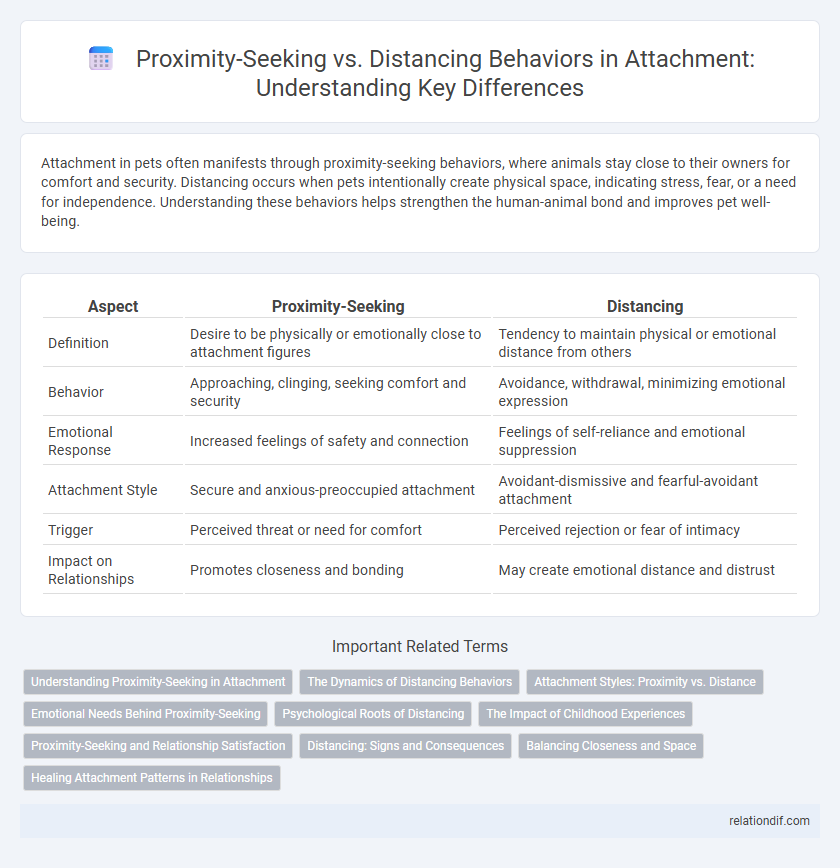Attachment in pets often manifests through proximity-seeking behaviors, where animals stay close to their owners for comfort and security. Distancing occurs when pets intentionally create physical space, indicating stress, fear, or a need for independence. Understanding these behaviors helps strengthen the human-animal bond and improves pet well-being.
Table of Comparison
| Aspect | Proximity-Seeking | Distancing |
|---|---|---|
| Definition | Desire to be physically or emotionally close to attachment figures | Tendency to maintain physical or emotional distance from others |
| Behavior | Approaching, clinging, seeking comfort and security | Avoidance, withdrawal, minimizing emotional expression |
| Emotional Response | Increased feelings of safety and connection | Feelings of self-reliance and emotional suppression |
| Attachment Style | Secure and anxious-preoccupied attachment | Avoidant-dismissive and fearful-avoidant attachment |
| Trigger | Perceived threat or need for comfort | Perceived rejection or fear of intimacy |
| Impact on Relationships | Promotes closeness and bonding | May create emotional distance and distrust |
Understanding Proximity-Seeking in Attachment
Proximity-seeking in attachment is a natural behavior driven by the need for safety and emotional security, typically observed in infants and children who instinctively move closer to caregivers when distressed. This behavior strengthens the attachment bond by ensuring protection and comfort, which promotes healthy emotional development and trust. Understanding proximity-seeking helps in identifying secure versus insecure attachment patterns, as excessive distancing may indicate avoidance or anxiety in relationships.
The Dynamics of Distancing Behaviors
Distancing behaviors in attachment dynamics manifest as efforts to maintain emotional or physical space to manage vulnerability and reduce distress. These behaviors often involve withdrawal, minimizing expressions of need, and suppressing attachment-related emotions to protect against perceived rejection or overwhelm. Understanding the interplay between proximity-seeking and distancing is crucial in therapeutic contexts, as it highlights the push-pull dynamics influencing attachment security and relationship stability.
Attachment Styles: Proximity vs. Distance
Attachment styles significantly influence proximity-seeking and distancing behaviors in relationships, where secure attachment fosters healthy closeness and emotional availability. Insecure attachment styles, such as anxious attachment, increase proximity-seeking due to fear of abandonment, while avoidant attachment promotes distancing to maintain emotional self-protection. Understanding these dynamics aids in addressing relational challenges and improving emotional regulation within interpersonal connections.
Emotional Needs Behind Proximity-Seeking
Proximity-seeking in attachment behavior reflects the fundamental emotional need for safety, comfort, and reassurance from significant others. It serves as a mechanism to regulate stress by maintaining closeness to attachment figures, which mitigates feelings of vulnerability and anxiety. Distancing, conversely, can indicate unmet emotional needs or defensive strategies to protect oneself from perceived rejection or emotional overwhelm.
Psychological Roots of Distancing
Psychological roots of distancing in attachment often stem from early experiences of inconsistency or emotional unavailability in caregivers, leading individuals to create emotional barriers for self-protection. This distancing behavior functions as a coping mechanism to manage anxiety and vulnerability by minimizing reliance on others. Research highlights that such patterns can result from unmet attachment needs, fostering avoidance and difficulties in forming close relationships.
The Impact of Childhood Experiences
Childhood experiences significantly shape attachment patterns, influencing whether individuals exhibit proximity-seeking or distancing behaviors in relationships. Secure attachment, often developed through consistent caregiving, fosters comfort with closeness and emotional intimacy, promoting proximity-seeking tendencies. In contrast, early neglect or trauma can lead to avoidant attachment styles, where distancing serves as a defense mechanism to cope with fears of rejection or abandonment.
Proximity-Seeking and Relationship Satisfaction
Proximity-seeking behavior, a core aspect of attachment theory, strongly predicts higher relationship satisfaction by fostering emotional safety and intimacy. Couples who engage in frequent proximity-seeking actions, such as physical closeness and responsive communication, experience enhanced trust and secure bonding. Empirical studies demonstrate that partners' active efforts to maintain closeness correlate with greater relationship stability and well-being.
Distancing: Signs and Consequences
Distancing in attachment is marked by emotional withdrawal, reduced communication, and avoidance of intimacy, often stemming from fears of rejection or vulnerability. This behavior can lead to increased feelings of loneliness, heightened stress, and impaired relationship satisfaction. Persistent distancing disrupts secure attachment formation, impacting emotional regulation and long-term relational stability.
Balancing Closeness and Space
Balancing closeness and space is essential in healthy attachment dynamics, as proximity-seeking behaviors foster emotional security and trust. Excessive closeness can lead to feelings of suffocation, while too much distancing may provoke anxiety and disconnection. Achieving an adaptive balance allows individuals to maintain intimacy while preserving autonomy, promoting stable and responsive relationships.
Healing Attachment Patterns in Relationships
Healing attachment patterns in relationships involves recognizing proximity-seeking behaviors as essential for emotional security, while understanding distancing tendencies as protective responses to perceived threats. Effective therapeutic approaches encourage safe emotional closeness and gradual vulnerability to rebuild trust and reduce anxiety. Strengthening secure attachment patterns promotes healthier connections and resilience in intimate partnerships.
proximity-seeking vs distancing Infographic

 relationdif.com
relationdif.com